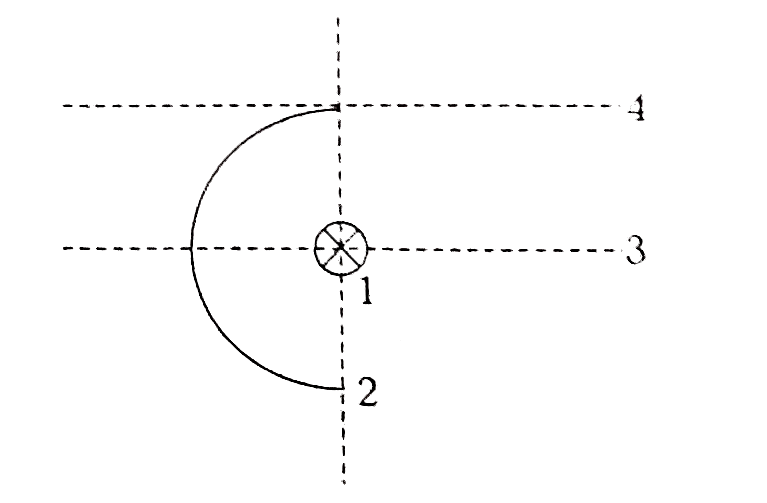Consider a an equilateral prism ABC of glass (μ=32) placed in water (μ=43)
_S01_067_Q01.png)
ColumnIColumnII(A)FGis parralel toBC(P)Maximum deviation(B)i1=90∘(Q)Minimum deviation(C)i1=i2=sin−1(916)(R)TIR will take place at surfaceAC(D)EFis perpendicular toAB(S)NoTIRwill take place at surfaceBCSolution in Gujrati
The correct Answer is:A, B, C, D
At minimum deviation i1=i2 , EF∣∣BC , At maximum deviation i1=90∘ori2=90∘
For i1=0,TIR will not take place at AC
Topper's Solved these Questions
- GEOMETRICAL OPTICSBOOK - ALLEN CHAPTER - GEOMETRICAL OPTICSEXERCISE - EXERCISE -01
65 Videos
- GEOMETRICAL OPTICSBOOK - ALLEN CHAPTER - GEOMETRICAL OPTICSEXERCISE - EXERCISE -02
82 Videos
- GEOMETRICAL OPTICSBOOK - ALLEN CHAPTER - GEOMETRICAL OPTICSEXERCISE - subjective
14 Videos
- CURRENT ELECTRICITYBOOK - ALLEN CHAPTER - CURRENT ELECTRICITYEXERCISE - EX.II
66 Videos
- GRAVITATIONBOOK - ALLEN CHAPTER - GRAVITATIONEXERCISE - EXERCISE 4
9 Videos
Similar Questions
On an X temperature scale, water freezes at −125.0∘X and boils at 375.0∘X. On a Y temperature scale, water freezes at −70.0∘Y and boils at −30.0∘Y. The value of temperature on X-scale equal to the temperature of 50.0∘Y on Y-scale is
View SolutionA triangular plate has two cavities , one square and one rectangular as shown in figure . The plate is heated.
_E01_066_Q01.png)
View SolutionA prism of refractive index n1 & another prism of reactive index n2 are stuck together without a gap as shown in the figure.The angle of the prisms are as shown. n1&n2depend onλ,the wavelength of light according to n1=1.20+10.8×104λ2&n2=1.45+1.80×104λ2 where λ is in nm.

(i)Calculate the wavelength λ0for which rays incident at any angle on the interfaceBCpass through without bending at that interface.
(ii) for light of wavelength λ0,find the angle of incidencei on faceACsuch that the deviation produced by the combination of prism is minimum.
View SolutionIn the Bohr's model of hy drogen atom, the electron moves around the nucleus in a circular orbit of radius 5×10−11m. Its time period is 1.5×10−16s. The current associated with the electron motion is:-
View SolutionAssertion : The difference in the value of acceleration due to gravity at pole and equator is proportional to square of angular velocity of earth.
Reason : the value of acceleration due to gravity is minimum at the equator and maximum at the pole.
View SolutionIn an equilateral prism of mu=1.5, the condition for minimum deviation is fulfilled. If face AC is polished Find the net deviation. If the system is placed in water what will be the net deviation for same angle of incidence? Refractive index of water =4/3.
View SolutionThe moment of inertia of thin square plate ABCD of uniform thickness about an axis passing through the center O and perpendicular to the plane of the plate is ( i ) I_(1)+I_(2) ( ii ) I_(2)+I_(4) ( iii ) I_(1)+I_(3) ( iv ) I_(1)+I_(2)+I_(3)+I_(4) where I_(1) , I_(2) , I_(3) and I_(4) are repectively moments of inertia about axes 1 , 2 , 3 and 4 which are in the plane of the plane
View SolutionConsider a uniform square plate shown in the figure. I_(1), I_(2), I_(3) and I_(4) are moment of inertia of the plate about the axes 1, 2, 3 and 4 respectively. Axes 1 and 2 are diagonals and 3 and 4 are lines passing through centre parallel to sides of the square. The moment of inertia of the plate about an axis passing through centre and perpendicular to the plane of the figure is equal to which of the followings. (a) I_(3) + I_(4) (b) I_(1) + I_(3) (c) I_(2) + I_(3) (d) (1)/(2) (I_(1) + I_(2) + I_(3) + I_(4))
View SolutionFour rods of equal length l and mass m each forms a square as shown in figure Moment of inertia about three axes 1,2 and 3 are say I_(1),I_(2) and I_(3) . Then, match the following columns {:(,"Column-I",,"Column-II"),("(A)",I_(1),"(p)",(4)/(3)ml^(2)),("(B)",I_(2),"(q)",(2)/(3)ml^(2)),("(C)",I_(3),"(r)",(1)/(2)ml^(2)),(,,"(s)","None"):}
View SolutionA semicircular ring has mass m and radius R as shown in figure. Let I1,I2,I3andI4 be the moments of inertia of the four axes as shown. Axis 1 passes through centre and is perpendicular to plane of ring. Then, match the following columns.

Column-IColumn-II(A)I1(p)mR22(B)I2(q)(3/2)mR2(C)I3(r)mR2(D)I4(s)Data is insufficient
View SolutionConsider a an equilateral prism ABC of glass (μ=32) placed in water (μ=43)
_S01_067_Q01.png)
ColumnIColumnII(A)FGis parralel toBC(P)Maximum deviation(B)i1=90∘(Q)Minimum deviation(C)i1=i2=sin−1(916)(R)TIR will take place at surfaceAC(D)EFis perpendicular toAB(S)NoTIRwill take place at surfaceBC
View Solutionकथन 1 . किसी प्रिज्म व्दारा उत्पन्न न्यूनतम विचलन प्रिज्म के अपवर्तनांक पर निर्भर नहीं करता हैं ।
कथन 2. किसी प्रिज्म के व्दारा उत्पन्न विचलन के व्यंजक δ=i1+i2−A में अपवर्तनांक निहित नहीं हैं ।
View SolutionIn a ΔABC, if (II1)2+(I2I3)2=λR2, where I denotes incentre, I1,I2andI3 denote centres of the circles escribed to the sides BC, CA and AB respectively and R be the radius of the circum circle of ΔABC. Find λ.
View SolutionWhat is the relation between angle of prism (A), angle of deviation (d), angle of incident (i1) and angle of emergence (i2) ?
View SolutionABC एकसमान मोटाई की समकोणिक त्रिभुजाकार प्लेट है । इसकी भुजाएँ इस प्रकार हैं की AB>BC. । यदि I1,I2 तथा I3 भुजाओं AB, BC तथा AC के परितः जड़त्व - आघूर्ण हों तो निम्न में से कौन - सा संबंध सही है

View SolutionAssertion : Minimum deviation for a given prism does not depend on the refractive index μ, of the prism.
Reason : Deviation by a prism is given by
δ=(i1+i2+A) and does not have the term μ.
View Solution
